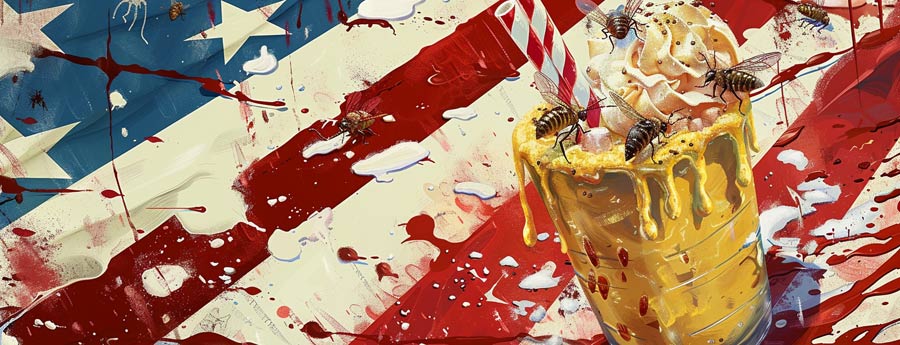
There are cracks in the foundation of dollar dominance. Could Chinese gold be the straw that breaks the dollar’s back?
 Bullion.Directory precious metals analysis 06 May, 2024
Bullion.Directory precious metals analysis 06 May, 2024
By Mike Maharrey
Journalist, analyst and author at Money Metals Exchange
In a column published by the Telegraph, economist Julian Jessop points out that people have been predicting the dollar’s demise for decades. Eventually, they’ll be right.
“And that day may be drawing much closer.”
It may seem premature to talk about the demise of the dollar. Based on the dollar index, the greenback is stronger than ever. But this doesn’t necessarily reflect the greatness of the dollar. It’s more a function of weakness in other global currencies. As the saying goes, the dollar is the cleanest dirty shirt in the laundry.
And if we look at the fundamentals underpinning the dollar, there are clearly issues.
The biggest problem is U.S. government borrowing and spending. Uncle Sam runs massive deficits every single month, requiring the Treasury to borrow more and more. The national debt has ballooned to $35.5 trillion and continues to rapidly increase. Constant federal government borrowing floods the global market with U.S. debt and dollars.
Of course, the world needs dollars. But the demand isn’t infinite. At some point, America’s fiscal irresponsibility will catch up with her.
Then what?
The Dollar Milkshake Theory
You may wonder how the dollar keeps plugging along despite U.S. monetary malfeasance.
Several factors underpin the greenback – chiefly its role as the global reserve economy.
In 2010, Santiago Capital’s Brent Johnson wrote a white paper that developed the “Dollar Milkshake Theory.” In a nutshell, Johnson argues that the dollar will generally strengthen during times of economic uncertainty because of its role as the reserve currency. Here’s how Medium summarized the theory:
“Imagine a milkshake made with different ingredients, such as milk, chocolate syrup, and vanilla ice cream. The milk represents the US dollar, the chocolate syrup represents other currencies, and the vanilla ice cream represents global liquidity. As the milkshake is blended, the ingredients are mixed together. However, the milk, which is the heaviest ingredient, settles at the bottom of the glass. This is similar to how the US dollar, as the strongest currency, tends to strengthen during times of economic stress.”
The Milkshake Theory assumes that the dollar will always remain the reserve currency and thus serve as a safe haven. But what happens if the world loses faith in the dollar?
Jessop points out three factors that underpin the dollar. Think of these as the milk in the Milkshake Theory…
- The U.S. has a strong institutional framework based on property rights and the rule of law. This makes the dollar a “relatively predictable and safe” asset.
- The size of the U.S. economy and the depth of its financial markets create a massive pool of dollar-denominated assets ideally suited as a global store of value.
- The vast majority of global trade takes place using dollars. That means the world needs a lot of dollars.
For these reasons, the world needs dollars and lots of them. But nothing guarantees the status quo will continue into perpetuity.
The Milk Is Getting Sour
Everybody loves a milkshake – unless the milk is sour. And there are signs that the milk in the dollar milkshake is starting to curdle.
The rise of the BRICS economic bloc is positioning itself to challenge the role of the dollar as the reserve currency.
BRICS is an economic cooperation bloc originally made up of Brazil, Russia, India, China, and South Africa. As of Jan. 1, 2024, the bloc expanded to include Saudi Arabia, Egypt, the UAE, Iran, and Ethiopia.
More than 40 other nations have expressed interest in BRICS membership.
The expanded BRICS has a combined population of about 3.5 billion people. The economies of the BRICS nations are worth over $28.5 trillion and make up roughly 28 percent of the global economy. BRICS nations also account for about 42 percent of global crude oil output.
The BRICS countries have expressed a desire to move away from dependence on the dollar. During last year’s BRICS summit, Brazil President Luiz Inacio Lula da Silva called on the bloc to create a common currency for mutual trade and investment. He said a BRICS currency would “increase our payment options and reduce our vulnerabilities.”
This could very well curdle the milk.
Central banks are already moving to diversify their assets and minimize their reliance on dollars. According to IMF data, the dollar made up about 71 percent of foreign reserves in 1999. But by 2020, the percentage had dropped to 59 percent.
De-dollarization is happening for both economic and political reasons. First, other countries don’t want to be overexposed to a rapidly depreciating asset. Second, they don’t want to put themselves in a position where the U.S. can use the dollar as a foreign policy hammer.
Jessop points out that the trend has flattened since the pandemic, but it’s a bit deceiving due to recent dollar strength compared to other currencies. “Beneath the surface, though, the diversification out of US assets has continued,” he said.
We see this in consistent central bank gold buying. According to the World Gold Council, central banks net gold purchases totaled 1,037 tons in 2023. It was the second straight year central banks added more than 1,000 tons to their total reserves.
China has led the way. The People’s Bank of China has increased its gold hoard for 17 straight months. China officially holds 2,262 tons of gold. The Chinese have added over 300 tons of gold to their reserve since they resumed reporting gold purchases in October 2022. And the country likely holds even more gold off the books.
Exchanging dollars for gold represents a significant power shift. Some analysts speculate that the movement of gold from West to East could set the stage for a gold-backed currency that would challenge dollar dominance.
Jessop concedes there might not be anything sinister going on. It could simply be a function of a shrewd PBOC investment strategy taking advantage of gold’s strength. But he also points out “there may still be a lot more to this story.”
“There are clear strategic advantages to China diversifying out of U.S. assets, largely given rising geopolitical tensions over Taiwan and Beijing’s growing assertiveness in the South China Sea … The switch to gold has helped China build up a war chest safe from U.S. sanctions. Russia has already taken this step, and other states may follow. China’s stockpiling of gold could also be a warning that the country could use its large holdings of U.S. government bonds as a weapon.”
The Telegraph recently published an article headlined “Xi Jinping’s vast gold war chest could let him take Taiwan without a fight.”
In effect, the Chinese have “sanction-proofed” their economy or at least minimized the United States’ ability to use the dollar as a weapon against them.
China has also dumped a large number of U.S. Treasuries. The country’s Treasury holdings have fallen to their current level of $775 billion from around $1.1 trillion in 2021. Chinese investment in U.S. debt hit a 14-year low in October.
Even so, China still holds a large amount of U.S. debt. As Jessop points out, “Any threat to dump these bonds could drive up the cost of borrowing, not just in the US but also in the rest of the Western world.”
And borrowing costs are already straining the U.S. Treasury.
Rising interest rates drove Uncle Sam’s interest payments to over 35 percent as a percentage of total tax receipts in fiscal 2023. In other words, the government is already paying more than a third of the taxes it collects on interest expenses, and those interest payments are rising every month.
The federal government spent $288.01 billion in interest expense to finance the national debt in the first quarter of fiscal 2024. That was more than national defense ($238 billion) and more than Medicare ($168 billion). The only higher spending category was Social Security at $351 billion.
And yet the borrowing and spending continues. As Jessop asserts, the United States is its own worst enemy.
“The recent strength of the economy and markets partly reflects a massive fiscal stimulus begun under President Trump and continued under President Biden. This is something that only a country issuing in the world’s dominant reserve currency could get away with, but the patience of international investors cannot be taken for granted.”
None of this means the U.S. dollar is going to collapse tomorrow. This could play out in a number of ways. We could simply see a further softening of the dollar and diversification of world reserves to other currencies. This would weaken the U.S. economy, but it wouldn’t necessarily lead to a crisis.
But there is a worst-case scenario. Jessop explains it this way:
“A sharp fall in the value of the dollar could have substantial negative effects elsewhere in the West, including spillovers into higher interest rates in the UK and the rest of Europe.”
This would be a disaster for Americans who are already struggling with high price inflation. If the U.S. dollar were to be dethroned from its position as the reserve currency, it could lead to hyperinflation.
As the saying goes, with great power comes great responsibility. It’s pretty clear that the United States government is not behaving responsibly.
Mike Maharrey


Mike Maharrey is a well-known author, journalist, financial analyst and writer at Money Metals Exchange, one of our top-rated US dealers and two-times winner of Bullion Dealer of the Year
He holds a BS in accounting from the University of Kentucky and a BA in journalism from the University of South Florida. Mike also serves as the national communications director for the Tenth Amendment Center and the managing editor of the SchiffGold website.
This article was originally published here
Bullion.Directory or anyone involved with Bullion.Directory will not accept any liability for loss or damage as a result of reliance on the information including data, quotes, charts and buy/sell signals contained within this website. Please be fully informed regarding the risks and costs associated with trading in precious metals. Bullion.Directory advises you to always consult with a qualified and registered specialist advisor before investing in precious metals.










 Material provided on the Bullion.Directory website is strictly for informational purposes only. The content is developed from sources believed to be providing accurate information. No information on this website is intended as investment, tax or legal advice and must not be relied upon as such. Please consult legal or tax professionals for specific information regarding your individual situation. Precious metals carry risk and investors requiring advice should always consult a properly qualified advisor. Bullion.Directory, it's staff or affiliates do not accept any liability for loss, damages, or loss of profit resulting from readers investment decisions.
Material provided on the Bullion.Directory website is strictly for informational purposes only. The content is developed from sources believed to be providing accurate information. No information on this website is intended as investment, tax or legal advice and must not be relied upon as such. Please consult legal or tax professionals for specific information regarding your individual situation. Precious metals carry risk and investors requiring advice should always consult a properly qualified advisor. Bullion.Directory, it's staff or affiliates do not accept any liability for loss, damages, or loss of profit resulting from readers investment decisions.

Leave a Reply